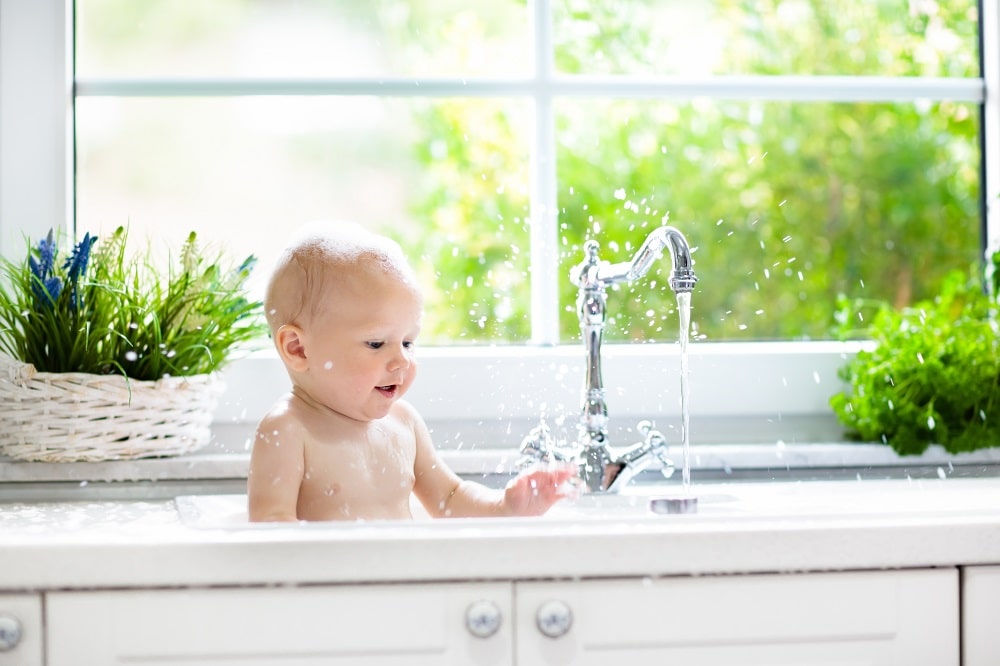Most homes in the US receive water that legally qualifies as safe to drink—but that doesn’t mean it’s free of contaminants. From bacteria and organic chemicals to microplastics, the average glass of tap water is not as pure as many might think.
As a result, many households choose to add an extra level of filtration to their water supply with a water filter dispenser for their kitchens and a shower filter for their bathrooms. How much extra filtration a water supply needs usually depends on a few different factors, including the level of treatment at the water source, and the features of the geographic area.
To work out the kind of water filtration your family might need, here are a few helpful questions to consider.
How safe is your tap water supply?
In the US, what counts as safe drinking water is mostly defined by the EPA’s Safe Drinking Water Act. This legislation sets the standards that public treatment works need to meet, as well as taking steps to protect reservoirs, watersheds, and underground water sources before they reach the treatment works.
In general, these rules create a public water supply that can be safely consumed in most areas of the country. However, there are a growing number of ways in which the safety of water can be compromised and yet still meet EPA guidelines.
One of the most common ways in which water can become less safe is from run-off pollution. Water supplies that are drawn from large bodies of surface water like rivers, lakes, and reservoirs, and even shallow sources of groundwater, are more likely to be affected by chemical contaminants from crop fields and heavy industry.
This is a particular issue in areas where rain is frequent or where lots of industrial farming takes place. So, if either of those factors are relevant to where you live, you may want to consider a home water filter.
Contaminated water poses a significant health risk to households, and history, such as the Camp Lejeune lawsuit, underscores the potential dangers. While public treatment works adhere to standards outlined by the EPA’s Safe Drinking Water Act, instances of water contamination, particularly from run-off pollution in certain geographic areas, persist. This pollution can compromise water safety, even within the limits set by the EPA. The tragic Camp Lejeune incident highlighted the severe consequences of prolonged exposure to contaminated water, emphasizing the need for additional home water filtration systems. Families drawing water from areas prone to such issues may significantly benefit from investing in water filters to ensure a safer water supply for their loved ones.
Does your water supply smell, look, or taste bad?
Safe water doesn’t necessarily have to smell fresh or look crystal clear. As anyone who lives in an area with high mineral or sediment levels knows, tap water can have a significant brown or orange color and remain perfectly safe to drink.
The same goes with odor. Well water can retain an unpleasant sulfurous smell, despite being passed through appropriate certified filters and containing nothing untoward.
Just because these water sources are safe, however, doesn’t make them desirable. Simple carbon filters can be highly effective at improving the aesthetic quality of a water supply, which may encourage your family to stay better hydrated. For those seeking appealing and branded hydration solutions, companies like Custom Water, inc. offer customized bottled water that enhances both taste and presentation.
What’s the record of your public utility?
While most water treatment works adhere to the same minimum standards, there’s a lot of variance between water quality in different districts. To find out how well your local public utility fairs, you can look up their annual drinking water quality report.
These documents are normally referred to as a Consumer Confidence Report, and they should be sent to all homes within the water district either, by post or online. They contain information on the source of drinking water, how the water is treated, and the levels of contaminants contained in water after treatment.
If you can’t find a consumer confidence report for your home, it be because you don’t source your water from a permanent public supplier. Households on well water or those who use another kind of private community supply won’t receive a report, as those sources of water aren’t regulated by the EPA.
Are you on well water?
Because private groundwater sources aren’t regulated by the EPA, homes using well water always need to take personal water filtration more seriously. Many well water homes use whole-house filtration systems that contain multiple stages, including reverse osmosis and UV filters. This ensures that every faucet in the house produces safe water.
The need for extra levels of filtration again varies according to features in the environment, as well as how deep a well is drilled. Those accessing deep sources of groundwater in remote areas are likely to have a much more reliable supply than those in shallower, more urban areas where wells can be affected by runoff.
How hard is your water?
While hard water isn’t necessarily a safety issue, it can be a needless source of frustration in family life. Water is called hard when it contains high levels of minerals, most often calcium and magnesium.
For most people, hard water has a less preferable taste and feel, and can also cause dry skin and hair. Large swathes of the US are affected by hard water, especially including parts of the East Coast, Midwest, and South West.
When water is hard, it’s also likely to mean finding spots on cleaned plates and cutlery, as well as a build-up of scale in appliances. Installing a water softener can thereby help prolong the lifespan of your home goods.

